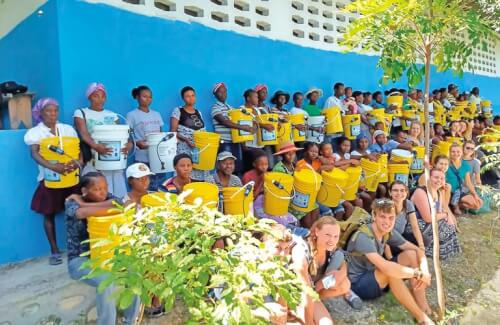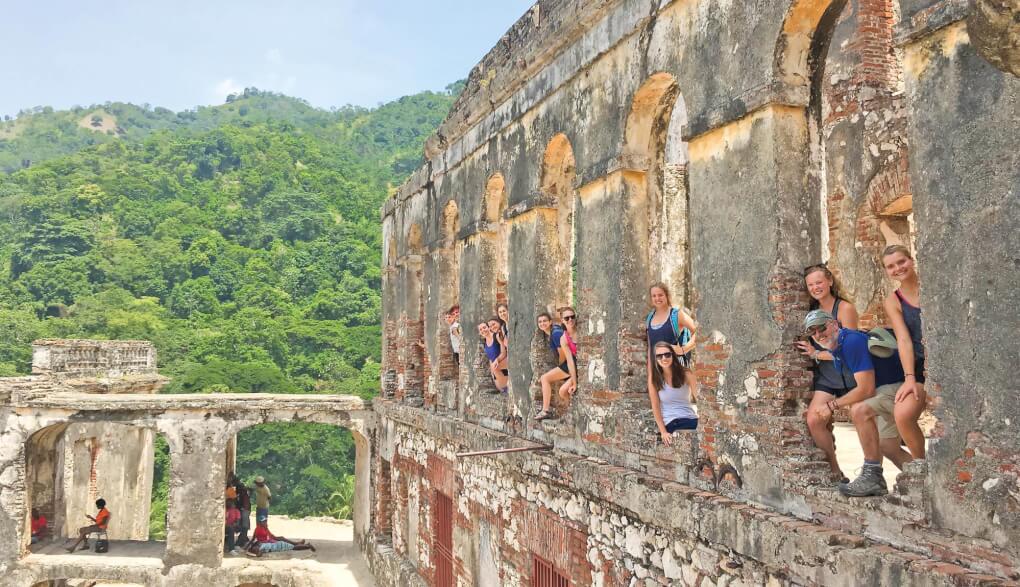pye bwa ki wo di wè lwen, gren pwomennen di li wè pase l’
This Haitian proverb, which roughly translates to “The tall tree sees far, but the wandering seed sees more,” served as the theme for a service-learning study abroad trip taken by a group of Lakers to Haiti this summer.
Peter Wampler, professor of geology and faculty-in-residence in the Frederik Meijer Honors College, and Kelly McDonell, honors academic and enrichment advisor, led the four-week expedition for 11 students from varying academic programs.
Wampler has been taking students to Haiti since 2008 to conduct research and facilitate service projects. He explained that the “wandering seed” proverb captures the essence of why he originally began these trips: to help change the negative narratives that are commonly connected to the health, environmental issues and security of Haiti.
“My hope is that students will be able to see the Haitian people, not a Haitian project,” said Wampler. “I think in most people’s minds, Haiti is a project that you’ve got to fix, and there are certainly things wrong that could be better, but there’s a lot of good things there, like strong people with amazing ethics about how they treat their family and even how they take care of their environment.”

Clean water for all
As an undergraduate student, Wampler had a professor with a particular passion for helping the people of Haiti flourish in their own environment — a cause that Wampler adopted himself.
“He was working in Haiti to help people learn how to access their natural resources, and I always admired him for that,” said Wampler. “After visiting Haiti myself, I fell in love with the people and the country as a whole. Then I saw the country’s huge need for water and people who could examine that problem.”
Providing the Haitian people with clean, drinkable water has always been a focal point of Wampler’s research and his students’ service projects in Haiti. During this summer’s expedition, students distributed 150 water filter systems to local residents.
Each filter has the potential to provide a family of up to five people with clean water for 20-30 years if the filters are properly cared for. Educating recipients on maintenance was a part of the project.
Hayley Schram, a 2017 Grand Valley graduate who participated in the 2016 trip to Haiti, helped evaluate hand-dug wells and test water samples in the village of Borel for two weeks.
“From this project, I learned that hand-dug wells are not suitable for most household purposes, including drinking, washing, bathing or laundry,” said Schram, who majored in geology.
Schram presented her research at the annual conferences of the Geological Society of America and American Institute of Professional Geologists, as well as the GVSU Global Health Showcase. The project won first place at both GSA and AIPG.
She said her work in Haiti inspired her to pursue a master’s degree in environmental science and engineering through which she can continue studying water and sanitation in low-income countries.

Service beyond water
Wampler plans one collective service project per trip for students, and encourages them to plan and facilitate individual projects, research or activities that are aligned with their majors.
This summer, Lukila Witthoeft, a sophomore majoring in behavioral neuroscience, taught 180 children an art lesson inspired by Haitian metal artwork. For the lesson, the children wrapped aluminum foil around a piece of cardboard and were asked to sketch whatever their creativity inspired using a small wooden stick. Witthoeft said this proved more challenging than expected for the children.
“The kids taught me a lot because they struggled with creativity and looked to me for explanations on what to design,” explained Witthoeft, from Charlevoix. “The kids have little opportunity to express their creativity due to limited class time and funding for art materials; however, some kids took the idea and ran with it by creating flowers, planes and trucks. Each kid was proud of what they made and I learned to take pride in what I achieved.”
Kayleigh Thomas, a junior majoring in exercise science, said the fine motor skills activities she organized for students ages 4-6 at two different sites helped her better appreciate the academic resources available in the U.S.
“I think that far too often we take simple things such as colored pencils and paper for granted when the children we interacted with shared one pencil between groups while practicing their writing,” said Thomas, from Rochester Hills.

Kelly Schultz, a mechanical engineering major, and Tyler Martin, a product design and manufacturing engineering major, led a bottle rocket workshop for about 100 local children. During the activity, plastic bottles were partly filled with water and launched into the air using a bicycle pump, improvised hose fittings and PVC pipe.
The children even decorated the bottles before launching them and watching them glide back to the ground.
“I hope that this experience inspired the children to think about how they can apply what they are learning in school to everyday life,” said Schultz, from Troy. “It would be incredible if this activity planted the seeds of curiosity in some of the children and encouraged them to pursue a STEM field.”
In the past, student-led projects and research have included teaching young students about the human body, playing musical instruments, teaching dance, working with local nonprofits, and observing doctors and dentists.
“My hope is that the students will be able to see the Haitian people, not a Haitian project.”
PETER WAMPLER

Haiti sandwich
These trips are designed in a format that Wampler has coined “Haiti sandwich,” with service projects and research taking place in-between cultural immersion and tourism experiences.
The top of the sandwich for this summer’s trip was the first week spent in Port-au-Prince and the surrounding area. During that week, students learned about the history and culture of Haiti while staying in what most would consider comfortable lodging with air conditioning and unlimited hot water.
For the following two weeks, the group members moved to a more rural area where they worked with staff at a local hospital and library, and stayed in lodging that Wampler said provided a more authentic Haitian experience.
“We were in a house where they had water for only three hours a day and they had to bucket flush the toilets. Plus, there was no air conditioning,” he said. “The middle of the sandwich is intentionally made more difficult for the students to get them out of their comfort zones and into the shoes of a Haitian.”
During the first part of the trip, the group’s favorite excursion was visiting Citadelle Laferrière, a fortress located on the top of the mountain Bonnet a L’Eveque in Milot. The massive stone structure was built from 1805-1820 in the aftermath of the slave revolution and declaration of its independence from France. It is the largest fortress in the Americas.
“It was a beautiful and amazing part of Haitian history that really represents the spirit and power of Haiti during their fight for independence,” said Megan DeKeyser, who is majoring in allied health sciences.
Another favorite adventure was to Basin Bleu, a waterfall that spills into a pool of crystal clear blue water that is tucked away on the outskirts of a small town near Jacmel.

Shifting perspectives
Reflecting on the trip, students said they share Wampler’s passion for changing the narrative around Haiti.
“Haiti taught me that there is so much more to people, places and situations than meets the eye,” said Thomas. “Even though Haiti is seen as a struggling nation, her people have a pride and dedication toward working to better the country for future generations, which was inspiring to witness.”
The trip taught Witthoeft the importance of building communities through love.
“Everyone looks out for one another and communities are self-regulated,” said Witthoeft. “No one is left alone. The Haitians love each other and I know the rest of the world could use this kind of love.”
Skyler Wickert said the trip to Haiti helped changed her perspective on her career path. Now, the sophomore behavioral neuroscience and nonprofit administration major will work toward becoming a human rights lawyer.
“I want to defend Haitians and other people who aren’t receiving basic human rights,” explained Wickert, from Gaylord. “This study abroad trip made me realize my genuinely deep passion for people, and I want to live my life serving others, ensuring they have an opportunity for a great life.”
More so than the epiphany Wickert experienced about her career path, she said her biggest takeaway was a deeper appreciation for the education she’s receiving at Grand Valley.
“I can’t explain the number of times we talked with Haitians who would love to continue their education, but are not able due to a lack of funds,” she said. “I’ve been provided a newfound love for attending classes and learning about anything and everything. As cliché as it sounds, this trip was life-changing.”
For more information about studying abroad in Haiti, visit gvsu.edu/haitistudyabroad.








